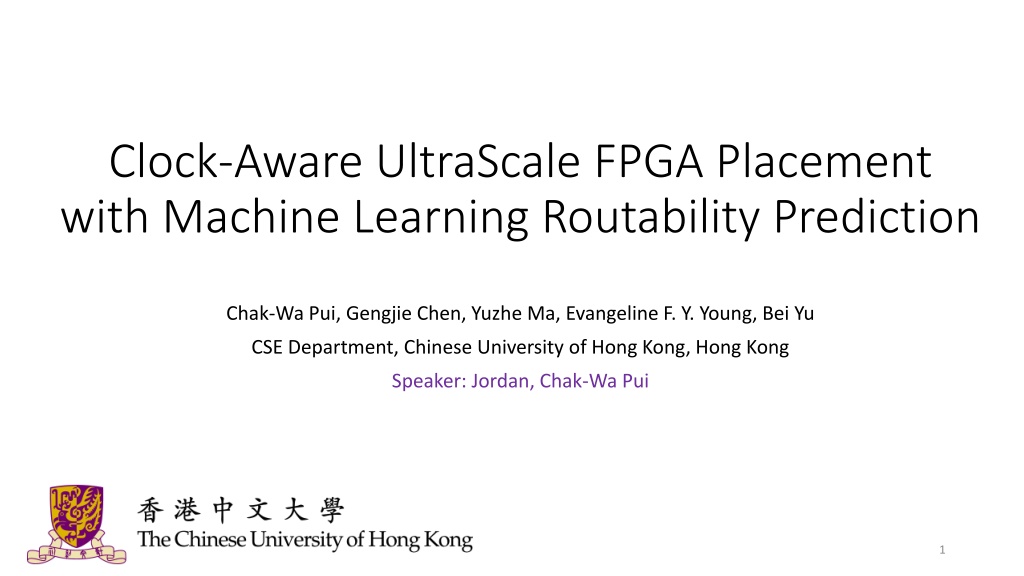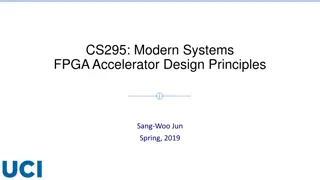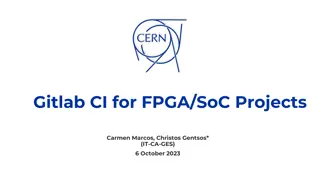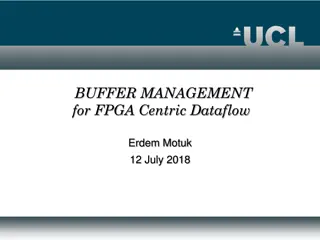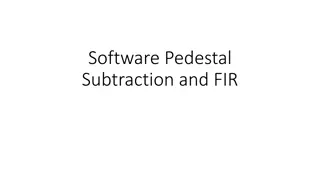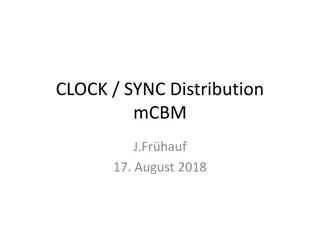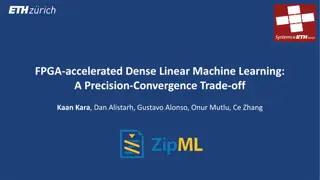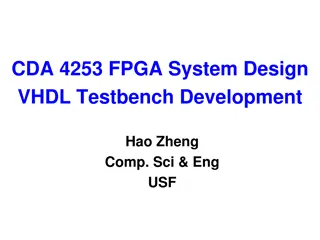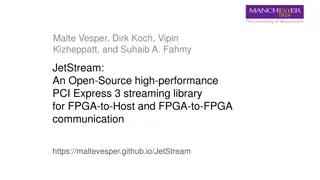Clock-Aware UltraScale FPGA Placement with Machine Learning Routability Prediction
The research focuses on addressing the challenges of clock constraints, routability, and wirelength in UltraScale FPGAs. Various placement techniques are introduced, such as two-step displacement-driven legalization and chain move, to optimize performance. The study incorporates different routability prediction methods and aims to minimize routed wirelength while adhering to specific architecture rules.
Uploaded on Oct 10, 2024 | 0 Views
Download Presentation

Please find below an Image/Link to download the presentation.
The content on the website is provided AS IS for your information and personal use only. It may not be sold, licensed, or shared on other websites without obtaining consent from the author. Download presentation by click this link. If you encounter any issues during the download, it is possible that the publisher has removed the file from their server.
E N D
Presentation Transcript
Clock-Aware UltraScale FPGA Placement with Machine Learning Routability Prediction Chak-Wa Pui, Gengjie Chen, Yuzhe Ma, Evangeline F. Y. Young, Bei Yu CSE Department, Chinese University of Hong Kong, Hong Kong Speaker: Jordan, Chak-Wa Pui 1
Outline Background Problem Formulation Algorithms Experimental Results Conclusion 2
Introduction The complex architecture of heterogeneous FPGAs yields more sophisticated placement techniques The gap between FPGA and ASIC placement becomes smaller Clock tree routing Scale Placement techniques etc. As the scale of FPGA grows rapidly routability becomes a major problem in FPGA placement IO SLICE DSP RAM Switch Box 2x30 sites 15x2 half columns 5x8 clock regions An illustration of Xilinx UltraScale architecture An illustration of clock architecture of UltraScale 3
Previous Works Routablility-driven placement for UltraScale FPGAs RippleFPGA[1] UTPlaceF[2] GPlace[3] Congestion estimation methods in FPGAs Probabilistic model[1][4] Global router[2] [1] RippleFPGA: A routability driven placement for large-scale heterogeneous FPGAs. ICCAD2016 [2] UTPlaceF: A routability-driven FPGA placer with physical and congestion aware packing. ICCAD2016 [3] GPlace: A congestion-aware placement tool for UltraScale FPGAs. ICCAD2016 [4] A congestion driven placementalgorithm for fpga synthesis. FPL2006 4
Contributions Several placement techniques for UltraScale FPGAs to meet the challenges of clock constraints, routability, wirelength A two-step displacement-driven legalization is introduced to remove all clock constraint violations Chain move is proposed to put a cell into a desired site efficiently We study the performance of different routability prediction methods in FPGAs All the above techniques are incorporated into our FPGA placer 5
Problem Formulation Clock-Aware Routability-driven FPGA placement Given the netlist and architecture of an FPGA Minimize: routed wirelength measured by VIVADO Subject to: each logic element has no overlap, no violation to the architecture specific legalization rules 6
Overview of Our Framework Flat netlist Clock planning Reduce congestion caused by unbalanced routing supply in the horizontal and vertical directions LUTs and FFs are packed into basic logic elements (BLEs) to reduce the inter-connections between sites in routing Partition re-allocation Legalization Packing Detailed placement Placed design Machine learning method is used to predict the routing congestion Global placement 7
Overview of Our Framework Flat netlist Violations of the clock region constraint in global placement will be removed The placement is first legalized such that no violations regarding to rules in ISPD2016. Then violations of the column region constraint will be removed by half column legalization and displacement Clock planning Partition re-allocation Legalization Chain move is used to improve wirelength Packing Detailed placement Placed design Global placement 8
Overview of Our Methods Two-Step Clock Constraints Legalization Chain Move Machine Learning-Based Congestion Estimation 9
Overview of Our Methods Two-Step Clock Constraints Legalization Clock Region Planning Half Column Legalization Chain Move Machine Learning-Based Congestion Estimation 10
Two-Step Clock Constraints Legalization Clock constraints of UltraScale FPGAs Clock region constraints Bound box of the clock net Column region constraints Loads of the clock net Displacement-driven two-step legalization Clock region planning Remove all the clock region violations after global placement Half Column Legalization Remove all the half column violations after legalization Clock region Half column 0 0 0 0 1 0 1 1 1 0 0 0 1 0 0 0 1 0 0 0 0 1 1 1 0 0 1 0 1 0 0 0 0 0 0 0 0 0 0 0 0 0 0 0 0 Usage of half column resources Usage of clock region resources 11
Two-Step Clock Constraints Legalization Two-Stage Clock region planning Assign a bounding box to each cell such that there will be no violation if they stay in the box Shrink Stage Expand Stage 12
Two-Step Clock Constraints Legalization Two-Stage Clock region planning Assign a bounding box to each cell such that there will be no violation if they stay in the box Shrink Stage iteratively shrink the bounding box of each clock shrink the BB of the clock in the most overflowed clock region such that it induces smallest displacement. Move the corresponding cells to the boundary. Expand Stage 1 2 2 1 0 1 2 2 1 0 1 2 2 1 0 1 2 3 2 1 1 2 2 2 1 1 2 2 2 1 2 3 4 2 1 2 3 3 2 1 1 2 2 2 1 1 2 3 2 1 1 2 2 2 1 1 2 2 2 1 1 1 1 0 0 1 1 1 0 0 1 1 1 0 0 13
Two-Step Clock Constraints Legalization Two-Stage Clock region planning Assign a bounding box to each cell such that there will be no violation if they stay in the box Shrink Stage Expand Stage iteratively expand the bounding box of each clock increase the width/height of the clock BB with highest cell density by 1 unit 2 2 2 2 2 1 2 2 1 0 1 2 2 1 0 1 2 2 2 1 2 2 2 2 2 1 2 2 2 1 1 2 2 2 1 1 2 2 2 1 2 2 2 2 2 1 2 2 2 1 1 2 2 2 1 1 2 2 2 1 1 2 2 2 1 1 2 2 2 1 1 2 2 2 1 2 2 2 2 2 1 1 1 0 0 1 1 1 1 1 1 1 1 1 1 2 2 2 2 2 14
Two-Step Clock Constraints Legalization Half Column Legalization All the future movement cannot induce any new half column violation Iteratively select the most overflow column and remove the clock s.t. the smallest displacement is induced Each load will be moved to its nearest site in another half column 15
Overview of Our Methods Two-Step Clock Constraints Legalization Chain Move Machine Learning-Based Congestion Estimation 16
c0 Chain Move c1 c2 rgn0 rgn1 Why? Reduce the quality loss due to sequential placement General Algorithm Generate a sequence of cell moves such that, all of cells involved are legal after the move the objective is improved DFS-based Limit the number of trials of each cell and the length of the chain The objective is optimized by selecting the candidate sites of each cell c3 rgn2 17
c8 c8 Chain Move c2 c1 c2 c3 c1 c3 c7 c4 c5 c6 c7 c4 c5 c6 Applications Reduce Max. and Avg. Displacement in Legalization Max. Displacement Mode Invoked when the displacement of ?? is larger than ???? The resulted chain move should satisfy: The total displacement should be no larger than the original The displacement of each moved cell should be no larger than the original disp(??) Avg. Displacement Mode Reduce the distance to optimal region in detailed placement 18
c2 c1 c2 c2 c1 c2 Chain Move c3 c4 c4 c3 c5 c5 Applications Reduce Max. and Avg. Displacement in Legalization Max. Displacement Mode Avg. Displacement Mode Invoked ?? cannot be legalized with displacement d The displacement of any cell ?? in the chain should satisfy, Reduce the distance to optimal region in detailed placement 19
c0 Chain Move c1 c2 rgn0 rgn1 c3 Applications Reduce Max. and Avg. Displacement in Legalization Max. Displacement Mode Avg. Displacement Mode Reduce the distance to optimal region in detailed placement The candidate cells of each cell are those that are in its optimal region rgn2 20
Overview of Our Methods Two-Step Clock Constraints Legalization Chain Move Machine Learning-Based Congestion Estimation 21
ML-Based Congestion Estimation Motivation: More accurate and Less parameter tunings Previously used congestion estimation methods in FPGAs Global routers for ASICs Probabilistic models Limitations: Not tailored for FPGAs A lot of parameters to set Goals of our methods Try to mimic the behavior of congestion estimation of design tools from the device company Assume the congestion estimation from the tool can guide the placement well Study how to leverage machine learning to build a congestion model on FPGA 22
ML-Based Congestion Estimation Congestion Model G-Cells based, each corresponds to a switchbox Three Features for each G-Cell Total number of pins of the net covering it A weighted sum of BB box covering it Combining the two 23
ML-Based Congestion Estimation Learning Models Local Linear Model Only consider the current site ? = ?=0 Hierarchical Hybrid Model Two-Layer Use the value of the local linear model as the first layer result ? ?1= ?=0 The second layer use the SVM as the machine learning model with the ? ?1 value of the site and its neighboring 8 sites as features ? ?2= ???? ? ?1 , ,? ?1 Global Linear Model Consider the current site and its neighboring 8 sites ? = ?=0 3 ???? 3 ???? 0 8 26???? 24
ML-Based Congestion Estimation Training Methods Unified model One model for all design Pros: generalize well Independent model Different model for different design Pros: capture the unique characteristics of different design Ensemble model Different model for different known design Ensemble all the known models to generate a model for new designs 25
ML-Based Congestion Estimation Result Analysis Training Method Model Unified is better than independent in our test Global models are better than local model Global linear model is best, SVM perform worse Both unified and ensemble model can generalize well to other designs Comparison Global routers for ASICs Cons: hard to set the routing capacity Probabilistic models Cons: only good correlation with the relative congestion level Machine Learning-Based Good correlation with the congestion level Give a better sense of congestion level Less parameter tuning 26
Experimental Result This Work 1st Place 2nd Place 3rd Place Design WL ratio Time ratio WL ratio Time ratio WL ratio Time ratio WL ratio Time ratio CLK-FPGA01 2011452 1 288 1 2208170 1.098 530 1.84 2209328 1.098 2686 9.326 2268532 1.128 2686 9.326 CLK-FPGA02 2167861 1 266 1 2279171 1.051 521 1.959 2273729 1.049 2788 10.481 2504444 1.155 2788 10.481 CLK-FPGA03 5265206 1 583 1 5353071 1.017 1038 1.78 6229292 1.183 3740 6.415 5803110 1.102 3740 6.415 CLK-FPGA04 3606567 1 380 1 3697950 1.025 725 1.908 3817377 1.058 2850 7.5 4085670 1.133 2850 7.5 CLK-FPGA05 4660136 1 569 1 4692356 1.007 943 1.657 4995177 1.072 3164 5.561 5180916 1.112 3164 5.561 CLK-FPGA06 5736998 1 591 1 5588507 0.974 1075 1.819 5605573 0.977 3570 6.041 6216898 1.084 3570 6.041 CLK-FPGA07 2325787 1 304 1 2444359 1.051 585 1.924 2504544 1.077 3698 12.164 2676088 1.151 3698 12.164 CLK-FPGA08 1778292 1 247 1 1885632 1.06 482 1.951 1989632 1.119 2504 10.138 2057117 1.157 2504 10.138 CLK-FPGA09 2530105 1 327 1 2601161 1.028 600 1.835 2583442 1.021 3158 9.657 2813538 1.112 3158 9.657 CLK-FPGA10 4495500 1 512 1 4464341 0.993 868 1.695 4770168 1.061 2971 5.803 4839765 1.077 2971 5.803 CLK-FPGA11 4189622 1 455 1 4182726 0.998 768 1.688 4207699 1.004 2535 5.571 4777177 1.14 2535 5.571 CLK-FPGA12 3387586 1 409 1 3368698 0.994 744 1.819 3376930 0.997 3007 7.352 3739517 1.104 3007 7.352 CLK-FPGA13 3833106 1 441 1 3815718 0.995 822 1.864 3920965 1.023 3155 7.154 4320345 1.127 3155 7.154 Average 1 1 1.03 1.84 1.073 7.933 1.126 7.933 Routed wirelength and running time (s) comparison with the ISPD 2017 contest winners 27
Experimental Result w/ CCL w/o CCL Design CLK-FPGA01 CLK-FPGA02 CLK-FPGA03 CLK-FPGA04 CLK-FPGA05 CLK-FPGA06 CLK-FPGA07 CLK-FPGA08 CLK-FPGA09 CLK-FPGA10 CLK-FPGA11 CLK-FPGA12 CLK-FPGA13 Average Comparison of HPWL and running time (s) before and after applying the two-step clock constraint legalization (CCL) HPWL 1582915 1577051 4059162 2716961 3532759 4485498 1708920 1355308 1946225 3505733 3270338 2592324 2927103 ratio 1 1 1 1 1 1 1 1 1 1 1 1 1 1.000 Time 288 266 583 380 569 591 304 247 327 512 455 409 441 ratio 1 1 1 1 1 1 1 1 1 1 1 1 1 1.000 HPWL 1582917 1577175 4060708 2717722 3533407 4486401 1708954 1354247 1945948 3506732 3270689 2593721 2926786 ratio 1.000 1.000 1.000 1.000 1.000 1.000 1.000 0.999 1.000 1.000 1.000 1.001 1.000 1.000 Time 276 254 558 367 534 572 293 244 313 499 440 395 420 ratio 0.958 0.955 0.957 0.966 0.938 0.968 0.964 0.988 0.957 0.975 0.967 0.966 0.952 0.962 28
Experimental Result RippleFPGA[1] This work Design FPGA01 FPGA02 FPGA03 FPGA04 FPGA05 FPGA06 FPGA07 FPGA08 FPGA09 FPGA10 FPGA11 FPGA12 Average WL ratio 1 1 1 1 1 1 1 1 1 1 1 1 1 WL ratio 1.002 0.999 1.000 0.985 1.000 1.000 0.992 0.994 1.005 1.007 0.958 1.051 0.999 350060 635044 3251264 5492214 9909270 6144522 9593240 8087931 12062928 6972278 10918250 7239553 350802 634700 3251721 5411107 9911182 6143973 9520252 8036647 12123865 7020054 10462601 7605996 Routed wirelength comparison between different routing congestion estimation models. [1] RippleFPGA: A routability driven placement for large-scale heterogeneous FPGAs. ICCAD2016 29
Conclusion A two-step displacement-driven legalization is introduced to remove all clock constraint violations with almost neglectable overhead in practice Chain move is proposed to put a cell into a desired site efficiently We study the performance of different routability prediction methods in FPGAs which save time in congestion-driven global placement and ease the burden of parameter tuning All of the above techniques together can achieve 3% shorter wirelength and about 2X runtime compared to ISPD2017 contest winner 30
Thanks 31
